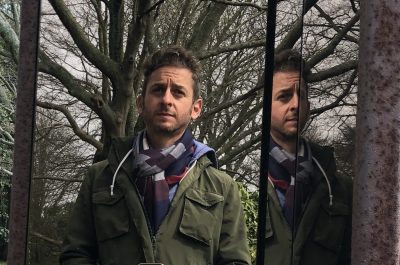MPA Creative Protector Award Recipient Ivan J. Arvelo: The Federal Agent Protecting Your Favorite Movies From Piracy
Director Ivan J. Arvelo is being honored with the 2025 Motion Picture Association Creative Protector Award for playing a crucial role in advancing our core mission of protecting intellectual property and bringing the magic of cinema to life.
As Director of the National Intellectual Property Rights Coordination Center (IPR Center), Arvelo leads the federal government’s efforts to protect creativity and innovation by enforcing laws that combat intellectual property crimes.
In this conversation, which has been edited for length and clarity, Director Arvelo discusses the challenges of fighting digital piracy, the sophisticated methods used by criminal organizations, and why protecting IP rights is essential for safeguarding the future of storytelling. He also reveals his favorite film franchise, a fitting selection for someone whose work involves protecting creators—we’ll give you a hint, one of the franchise’s most iconic lines is “You shall not pass.”
Can you explain your job to film and TV lovers who may not be familiar with what you do and how it connects to the movie and television industry?
I serve as the director of the National Intellectual Property Rights Coordination Center. The IPR Center, as it’s commonly known, is a federal government center that leads the federal government’s efforts in protecting creativity and innovation, and enforces laws to combat intellectual property crimes.
We have jurisdiction across everything counterfeit and everything related to IPR crimes. We work closely with government agencies, industry, industry associations, and international partners to collaborate on the common goal of combating intellectual property crime. In the film industry, we collaborate with industry associations on content protection and digital piracy. It’s not only the MPA—it’s every industry that involves combating transnational criminal organizations seeking to profit through the theft of intellectual property. That way, we can protect creativity and innovation. We are focused on economic stability in the United States, prioritizing the protection of public health and safety, and maintaining national security across the board.
That’s a massive job with a very large remit. What are some of the biggest challenges that you face in protecting IP rights, specifically in the movie and TV industry?
I’m going to outline the top three challenges that I believe we encounter every day. Obviously, technology and its advancements must be at the top. I’ve been doing this long enough to remember the days when pirated DVDs were being sold on street corners. With the rapid advancement of technology, the methods of piracy evolve and change. Now everything is online, and you have illicit streaming services that can reach millions of people at any given time, and in real time. That makes it harder for enforcement agencies to be successful in countering that.
And it’s not as if there’s a roomful of people in a basement in Ohio responsible for pirating movies—most of these operations are based overseas.
If you add to that the fact that piracy is a borderless crime, but enforcement is not, the networks have moved beyond the United States; they’re outside our borders, which requires us to work with our international partners. Not every jurisdiction has the same understanding of intellectual property rights laws. They don’t have the same resources. They don’t have the same appetite to enforce these laws. Therefore, it requires constant collaboration and capacity building, as well as working with industry and our international partners, to have an impact.
What’s the third top challenge?
Number three is awareness. It has become socially acceptable to a certain extent. People tend to believe that streaming an illegal movie is a victimless crime. They underestimate the harm that piracy has on the creators, on the industry and to themselves, because sometimes when you log into one of these sites, you’re exposing yourself to malware, your information is being stolen, your financial information is being sold, plus you are supporting a transnational criminal organization that might be involved in other things like human trafficking, money laundering, and terrorism. Those are some of the things that we deal with on a daily basis.
In your career, is there a particular case that stands out to you involving a TV series or movie that would help explain this to regular movie and TV lovers?
I’m going to mention one that was recent and I think had an impact. It shows the extent to which piracy has reached. This case specifically involves piracy networks called Streameast, a large-scale illegal streaming network that distributed sporting events worldwide, reaching a level where famous people were using it. [Editor’s note: Streameast was a network of unauthorized domains that generated 1.6 billion combined visits over the past year. Streameast provided access to the world’s most popular sports, including the NFL, NBA, MLB, and Europe’s top soccer leagues, including the Premier League and Champions League.]
Working in collaboration with our partners, such as the MPA, we were able to seize over 470 domains tied to these illegal streaming operations, which is a significant number. A case like this has an impact—it prevents financial damage to the industry because we’re taking it down, and people need to be directed to the legitimate sites. However, I believe it also sends a message across the piracy ecosystem that law enforcement is collaborating with industry, and we’re working together with technology platforms to ensure that we identify these networks and take them down. It’s all about collaboration. This is just one network. Just like that one, hundreds are operating around the globe, and we have hundreds of investigations. However, this recent one, due to the large number of domains we were able to seize, is a good example.
Pirates are getting increasingly sophisticated. How do they adapt to your measures?
Pirates are highly adaptive. For every measure that we put forth, they have a countermeasure. They start by moving their operations overseas. The advancement of technology gives them anonymity. When you move your operation overseas, it becomes more challenging for law enforcement to locate and apprehend those involved.
What kind of new technologies are they deploying?
They utilize every technology they can find for their operations—cryptocurrencies, bulletproof hosting providers, and encrypted communications networks—and continually add layers of complexity to their operations. Every time we take a pathway down, whether it’s through site takedown, domain seizure, or any other technical measure, something else resurfaces quickly. They use mirror sites, decentralized platforms, and peer-to-peer technologies like IPTV.
How do you combat that?
The best strategy for us is to continue to work together with industry and have a more multi-layered approach. It’s not only enforcement—it’s the disruption of revenue streams, because at the end of the day, the motivation for crime is financial. If we hit them where it hurts, we can get them to move away from this arena. We work with payment processors, ad networks, and hosting providers to cut off the financial incentive.
In collaboration with industry and industry organizations, such as the MPA, and working together with government organizations like the IPR Center, as well as technology platforms, we can reach a point where we can tip the scales of risk versus reward. Ultimately, if the risk outweighs the reward, we will be successful. Part of that is education—we need to continue educating people about the dangers of piracy and the value of supporting legitimate platforms. If you don’t have the consumer, then the money won’t be there, and the illegal operations will have to move on.
How do you make that case to consumers that the effect of piracy is real and not just a ledger loss for a big corporation?
One of the things that I’ve learned is that IPR affects everyone. When you consider our mission and the importance of protecting the industry and the economic stability of the United States, it’s essential to remember that there are real people behind it. It’s about protecting the creators. It’s about protecting the people who work behind the cameras. It’s about protecting consumers who enjoy going to the movies. For me, I find that the work we do here—the larger effect we’re trying to achieve—is to continue safeguarding the industry for the next generation. It’s not only about protecting the people who are doing it now. It’s about keeping the industry going for the next generation of creators and storytellers.
This is one of the points we’ve been making for years at The Credits: that the vast majority of the film and TV industry is comprised of hardworking individuals who aren’t earning millions and whose names aren’t featured on posters or ads.
I am a movie lover. I grew up loving watching movies, and it’s a big part of my life. So I take tremendous pride and satisfaction in knowing that the efforts that we put forth here at the IPR Center have some effect on that. What I do here is going to have an impact on the future of the industry. Hopefully, at some point, we will reach an environment where creativity can flourish and innovation is rewarded, not stolen. I don’t think we’re there yet, but that is our goal here at the IPR Center. We’ll continue to work towards that, knowing that, beyond everything we do, at a larger level, the impact we have is really helping a group of people behind the scenes who are not usually getting the attention they deserve for their work.
Okay, let’s pivot then to a movie you love—do you have a favorite movie that you love so much that you rewatch it?
I’m going to geek out now. The Lord of the Rings trilogy is a movie that I rewatch—I try to go through all of them once a year. I can tell you, there are a hundred movies that I love, but for some reason, it’s that trilogy for me, and it’s not only me. I have my oldest son, who is now 30, and he’s also a movie lover. That’s one of the things that bonds us together. He doesn’t live near me—he’s in another city—but when he comes over, we try to sit down, and that’s our movie, our go-to movie. Peter Jackson—amazing work.
Featured image: Ivan J. Arvelo. Courtesy of the IPC Center.



